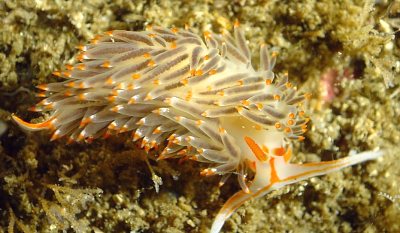
Phidiana sp 1
- Senegal
Order: NUDIBRANCHIA
Suborder: AEOLIDINA
Family: Glaucidae
PHOTO
Dakar, Senegal, Eastern Atlantic. Site: Medoun., Depth: 34m., Size: 40-45mm. June 06, 2003. Photos: Marina Poddubetskaia
Nothing is known of its internal anatomy so its generic placement is tentative. Has colour similarities to Phidiana militaris. See messages below.
Authorship detailsRudman, W.B., 2003 (June 29) Phidiana sp 1 - Senegal. [In] Sea Slug Forum. Australian Museum, Sydney. Available from http://www.seaslugforum.net/find/phidsp1
Related messages
Phidiana militaris? from Senegal
July 1, 2003
From: Marina Poddubetskaia
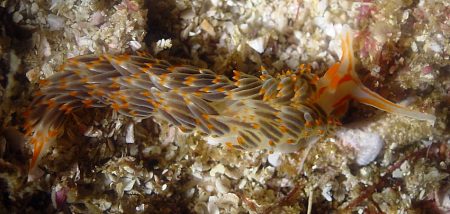
Dear Bill,
Here are 2 specimens of what I think is Phidiana militaris from Dakar. I was really surprised to find this Indo-West Pacific species here, in Atlantic waters. But all distinctive characteristics seem to fit this ID : orange lines on the head and on each side of the foot are present. I have added the third photo because it is the only one which allows to see the characteristic line on the foot.
Bill, have a close look at Patrice Petit de Voize's earlier photo. We identified it as Berghia verrucicornis. In fact, now I'm quite sure it is the same species as this one!
Upper Photo: Dakar, Senegal, Eastern Atlantic. Site: Banc du Seminole, Depth: 26m, Size: 35-40mm. May 27, 2003. Other Photos: Dakar, Senegal, Eastern Atlantic. Site: Medoun., Depth: 34m., Size: 40-45mm. June 06, 2003. Photos: Marina Poddubetskaia - Nembro website
Best wishes,
Marina.
nembro@nembro.info
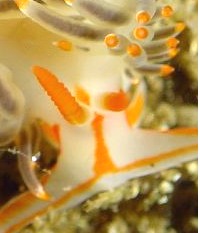

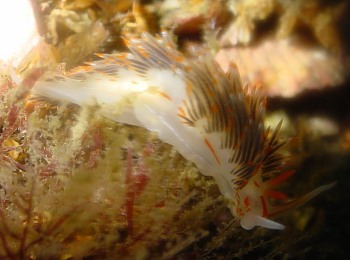
Dear Marina,
Although it has colour similarities to Phidiana militaris, in particular the median orange line that forks on the head, there are differences. In P. militaris the colour pattern includes red-orange and yellow. While the longitudinal lines are red-orange, the tips of the oral tentacles, rhinophores and cerata are yellow. There is also a yellow median line on the posterior part of the foot. There are also blue markings on the cerata. Also the rhinophores are smooth while in your animal the wrinkles on the rhinophores appear to be permanent not just the result of rhinophore contraction.
However the only way to be sure would be to look at its anatomy. The arrangement of the cerata is certainly typical of a glaucid genus like Phidiana so I'll give it a temporary home as Phidiana sp. 1, though its anatomy might say otherwise. AS you suggest, its probable that Patrice's photo is of the same species. It is an interesting find
Best wishes,
Bill Rudman
Berghia verrucicornis from Senegal
May 1, 2003
From: Marina & Patrice
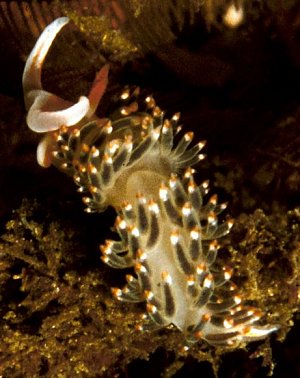
Dear Bill,
The adventure from Dakar (Senegal) continues with this eolid. Could you confirm that it is the colour form of Berghia verrucicornis described by Malcolm Edmunds, please?
Patrice took this photo in April 1999 at a depth of 18m. The name of the site was ‘Gouye teni M'bot’ which meaning is ‘the baobab in front of the M'bot quarter’.
Best wishes,
Marina Poddubetskaia
nembro@nembro.info
Patrice Petit de Voize
PdeVoize@aol.com
Poddubetskaia, M. & Petit de Voize, P., 2003 (May 1) Berghia verrucicornis from Senegal. [Message in] Sea Slug Forum. Australian Museum, Sydney. Available from http://www.seaslugforum.net/find/9674Dear Marina & Patrice,
As far as I can see it fits Malcolm Edmunds description of B. verrucicornis from Ghana. However I can't see whether the rhinophores are papillate, and they don't seem to have a white tip as he describes.
• Edmunds, M. (1968) Eolid Mollusca from Ghana with further details of west Atlantic species. Bull. Mar. Sci. 18: 203-219.
Best wishes
Bill Rudman
